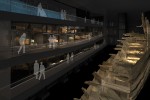 The high-pressure jets that sprayed the Mary Rose with fresh water and polyethylene glycol (PEG) for close to 30 years have been turned off. This is an important milestone in the decades-long preservation of the Tudor flagship which sank before Henry VIII’s horrified eyes off the coast of Plymouth on July 19th, 1545. The fine silt of the seabed kept the hull of the ship, the remains of its crew and 19,000 artifacts in eerily good condition until the whole thing was raised in 1982. The Mary Rose was kept in a cold room at 95% humidity and sprayed by jets of chilled filtered, recycled water for 10 years to flush out the corrosive salts, keep the wood cold, prevent it from drying out and from being assaulted by microbes. If it had not been kept constantly wet, the timbers could have shrunk by as much as 50% as water evaporated, leaving a withered, brittle, warped husk behind. Next the ship was sprayed with PEG for 19 years to replace the water in the wood’s cells with a waxy substance that does not evaporate even when dry.
The high-pressure jets that sprayed the Mary Rose with fresh water and polyethylene glycol (PEG) for close to 30 years have been turned off. This is an important milestone in the decades-long preservation of the Tudor flagship which sank before Henry VIII’s horrified eyes off the coast of Plymouth on July 19th, 1545. The fine silt of the seabed kept the hull of the ship, the remains of its crew and 19,000 artifacts in eerily good condition until the whole thing was raised in 1982. The Mary Rose was kept in a cold room at 95% humidity and sprayed by jets of chilled filtered, recycled water for 10 years to flush out the corrosive salts, keep the wood cold, prevent it from drying out and from being assaulted by microbes. If it had not been kept constantly wet, the timbers could have shrunk by as much as 50% as water evaporated, leaving a withered, brittle, warped husk behind. Next the ship was sprayed with PEG for 19 years to replace the water in the wood’s cells with a waxy substance that does not evaporate even when dry.
 Visitors to the Mary Rose Ship Hall in Portsmouth Historic Dockyard have been able to view the ship for most of this time. In 2009, the hall was closed to make way for the construction of a new museum large enough to display the ship and most of its artifacts together in one place. The Mary Rose was moved to a nearby dry dock and placed inside an air-tight lucite container known as the hotbox. The new museum building was constructed around it.
Visitors to the Mary Rose Ship Hall in Portsmouth Historic Dockyard have been able to view the ship for most of this time. In 2009, the hall was closed to make way for the construction of a new museum large enough to display the ship and most of its artifacts together in one place. The Mary Rose was moved to a nearby dry dock and placed inside an air-tight lucite container known as the hotbox. The new museum building was constructed around it.
 Now the drying phase of the project begins, just in time for the opening of the new museum on May 31st. The hull of the Mary Rose, still inside the hotbox, is in the center of the new building with galleries running down its length on either side at the same levels as the decks of the ship. As many as 70% of the 19,000 artifacts will be on display in these galleries in the areas in which they were found. Only 5% could be displayed in the previous facility. Artifacts range from everyday use objects like wooden bowls and tankards to fine pewter and silver officers’ ware to cannons to nearly 500 shoes. The skeleton of the ship’s dog, a little terrier conservators have named Hatch because he was found trapped in the door of the carpenter’s cabin when the Mary Rose sank, will also be on view. The idea is to convey the feeling of actually being on board, of seeing what the sailors saw on the decks of the ship just before she went down.
Now the drying phase of the project begins, just in time for the opening of the new museum on May 31st. The hull of the Mary Rose, still inside the hotbox, is in the center of the new building with galleries running down its length on either side at the same levels as the decks of the ship. As many as 70% of the 19,000 artifacts will be on display in these galleries in the areas in which they were found. Only 5% could be displayed in the previous facility. Artifacts range from everyday use objects like wooden bowls and tankards to fine pewter and silver officers’ ware to cannons to nearly 500 shoes. The skeleton of the ship’s dog, a little terrier conservators have named Hatch because he was found trapped in the door of the carpenter’s cabin when the Mary Rose sank, will also be on view. The idea is to convey the feeling of actually being on board, of seeing what the sailors saw on the decks of the ship just before she went down.
 The drying process is expected to take four of five years. Conditioned air will slowly remove the estimated 100 tons of water remaining in the hull. The hotbox is inside a casing so it’s not fully open to public view, but there are windows for visitors to peer through and see the ship as it dries. Once the wood is completely dry, hopefully in 2017, the casing will be removed and the Mary Rose will be visible in all her glory down the middle of the museum.
The drying process is expected to take four of five years. Conditioned air will slowly remove the estimated 100 tons of water remaining in the hull. The hotbox is inside a casing so it’s not fully open to public view, but there are windows for visitors to peer through and see the ship as it dries. Once the wood is completely dry, hopefully in 2017, the casing will be removed and the Mary Rose will be visible in all her glory down the middle of the museum.
The Mary Rose is a unique time capsule of Tudor life (quick, somebody call it the Tudor Pompeii of the ocean!). It was Henry’s favorite ship, named after his favorite sister Mary and the Tudor emblem of the rose. It was the first ship to fire a broadside. It’s the only 16th century warship on display in the world and the vast collection of artifacts that have survived and been conserved provide us with a one-of-a-kind glimpse into the daily life of board a ship of that era and of Tudor society in general.